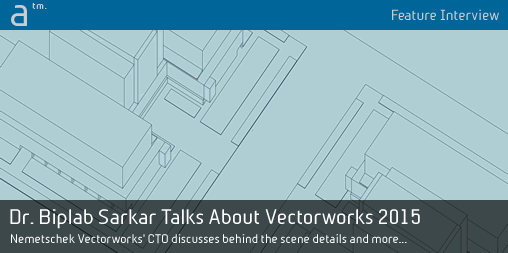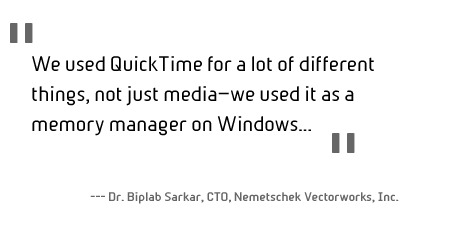Every fall like clockwork Nemetschek Vectorworks, Incorporated, announces its latest version of its namesake BIM/CAD software—the global marketshare Mac and Windows CAD leader. It is also arguably the number one CAD program in Japan. This year was no different—the world now knows what the Vectorworks 2015 product line-up is all about.
MORE: Nemetschek unveils new Vectorworks 2015 CAD/BIM tool publicly
Shortly after the announcement, I got a chance to talk to Dr. Biplab Sarkar, chief technology officer of Nemetschek Vectorworks and the man responsible for strategic direction behind the software architectures and technologies and the growing team of software programmers and engineers now scattered between offices in the United States and eastern Europe.
The 64-bit Long Trail
One of the big new features in this year’s update to Vectorworks, and the one the company leads off with in its promotional materials, is the new 64-bit code base. The entire program is now 64-bit—on both Mac and Windows platforms. The effort didn’t come easy, notes Dr. Sarkar. “Actually we started the conversion process back in 2010, so it took us four years to get here,” says Sarkar.
So what was the big hold-up?
The main effort was begun by changing the API (application programming interface) frameworks from Apple’s old Carbon framework to the new Cocoa framework which was introduced when OS X was unveiled back at the turn of the century. But as Dr. Sarkar is quick to point out, with Apple they have had to re-write their code base a fair amount more than with Windows.
“If you recall from our previous versions we would note which parts of the program were now Cocoa-based,” says Sarkar. “These piecemeal Cocoa conversions finally wrapped up with this release, where even the main work window is now [in version 2015] Cocoa-based.”
It was also important to learn how QuickTime played a role in the effort to 64-bit. As Dr. Sarkar explained, “we used QuickTime for a lot of different things, not just media—we used it as a memory manager on Windows at one time.” “So we re-wrote our own memory manager a few versions ago.”
Despite all this new 64-bit code base, users need an education in what it all means for them. As Sarkar explained, while there are some speed improvements, the primary benefit of the 64-bit code isn’t about speed but rather the ability for the program to handle much larger files— and BIM models—and still perform very well.
Committed to Apple’s Swift
You might think that after finishing up such a multi-year effort brought upon by Apple’s programming model changes that the last thing the company would want to commit to is another one. But you would be wrong. At least partly!
With Vectorworks 2015 firmly in the rear-view mirror the programming staff at Nemetschek Vectorworks is already planning for the necessary adjustments in learning the new Apple Swift programming language. Why? Well, obviously because they see the benefits that lay ahead in doing so. (see, Wired, “Why Apple’s Swift Language Will Instantly Remake Computer Programming”, 14 July 2014)
But let’s recap a little history to but this part in better perspective. Back at version 2009 the company had announced a major switch-over to the Parasolid modeling kernel by Siemens PLM. That work involved phased switch-outs much like the Carbon to Cocoa API work. Then starting with the last version we learned that the Vectorworks team decided to write their own rendering engine pipeline called Vectorworks Graphics Model, which is similar to HOOPS and the Unity game engine as a technical blend, and that landed in users’ laps in version 2014 last year. That’s a lot of plumbing work!
So this begged an obvious question: with all that foundational work behind them, wouldn’t the company now be in a great position to focus future updates nearly exclusively on new features and feature improvements?
next page: Vectorworks Graphics Module—Act Two





Reader Comments
darned autocorrect! Vectorworks!
Anthony How does the new underpinnings of vector work respond to the multicore abilities of the Latest MacPro? DO the Mac Pro Graphics Capabilities give a more fluid and detailed modeling environment?
Anthony How does the new underpinnings of vector work respond to the multicore abilities of the Latest MacPro? DO the Mac Pro Graphics Capabilities give a more fluid and detailed modeling environment?
darned autocorrect! Vectorworks!
darned autocorrect! Vectorworks!
Louis, most of the 3D programs for Mac, including CAD programs are predominantly single-threaded applications. Even in say a program like Cinema 4D, when you are editing an element in the main viewport, that work is mostly single-threaded (see: Architosh, “Firm Profile: Archiform 3D–Challenging China with Integral Design”, 12 Feb 2014). Same for CAD programs like Vectorworks.
Multicores come into play for those multi-threaded segments of the program like photorealistic rendering. In that feature mentioned above, Steve Bell laments that one actually wants a super clockwise fast processor and a bunch of multi-core processors kinda all in the same machine. Such an impossibility is the ideal.
Vectorworks does not do a lot with multithreading outside of Renderworks. So the best Mac Pro (nMP) would be the highest frequency quad core option. As for the nMP’s dual GPUs? Some apps like Mari were specifically written to utilize them. For OpenGL apps Apple has instructed developers on various ways to leverage both GPUs on both the OpenGL and OpenCL level. This is not done through a kind of AMD Crossfire for Mac (which doesn’t exist) but rather specific programming techniques for OS X.
One last point to your question. I would imagine given the over-all system strength of the nMP, that they would give the most fluid modeling environment for Vectorworks 2015 3D work, over say the fastest i7 based iMac. Though not by a lot. The Quadcore nMP is at 3.7GHz and the fastest iMac is at 3.5GHz with a quad core i7. It depends on what GPU you throw into the equation after that.
Louis, most of the 3D programs for Mac, including CAD programs are predominantly single-threaded applications. Even in say a program like Cinema 4D, when you are editing an element in the main viewport, that work is mostly single-threaded (see: Architosh, “Firm Profile: Archiform 3D–Challenging China with Integral Design”, 12 Feb 2014). Same for CAD programs like Vectorworks.
Multicores come into play for those multi-threaded segments of the program like photorealistic rendering. In that feature mentioned above, Steve Bell laments that one actually wants a super clockwise fast processor and a bunch of multi-core processors kinda all in the same machine. Such an impossibility is the ideal.
Vectorworks does not do a lot with multithreading outside of Renderworks. So the best Mac Pro (nMP) would be the highest frequency quad core option. As for the nMP’s dual GPUs? Some apps like Mari were specifically written to utilize them. For OpenGL apps Apple has instructed developers on various ways to leverage both GPUs on both the OpenGL and OpenCL level. This is not done through a kind of AMD Crossfire for Mac (which doesn’t exist) but rather specific programming techniques for OS X.
Louis, most of the 3D programs for Mac, including CAD programs are predominantly single-threaded applications. Even in say a program like Cinema 4D, when you are editing an element in the main viewport, that work is mostly single-threaded (see: Architosh, “Firm Profile: Archiform 3D–Challenging China with Integral Design”, 12 Feb 2014). Same for CAD programs like Vectorworks.
Multicores come into play for those multi-threaded segments of the program like photorealistic rendering. In that feature mentioned above, Steve Bell laments that one actually wants a super clockwise fast processor and a bunch of multi-core processors kinda all in the same machine. Such an impossibility is the ideal.
Vectorworks does not do a lot with multithreading outside of Renderworks. So the best Mac Pro (nMP) would be the highest frequency quad core option. As for the nMP’s dual GPUs? Some apps like Mari were specifically written to utilize them. For OpenGL apps Apple has instructed developers on various ways to leverage both GPUs on both the OpenGL and OpenCL level. This is not done through a kind of AMD Crossfire for Mac (which doesn’t exist) but rather specific programming techniques for OS X.
One last point to your question. I would imagine given the over-all system strength of the nMP, that they would give the most fluid modeling environment for Vectorworks 2015 3D work, over say the fastest i7 based iMac. Though not by a lot. The Quadcore nMP is at 3.7GHz and the fastest iMac is at 3.5GHz with a quad core i7. It depends on what GPU you throw into the equation after that.
Dr. Biplab Sarkar Talks to Architosh About Nemetschek @Vectorworks 2015 http://t.co/dg3uFc4oLs by Anthony Frausto-Robledo #aec #cad
Dr. Biplab Sarkar Talks to Architosh About Nemetschek @Vectorworks 2015 http://t.co/dg3uFc4oLs by Anthony Frausto-Robledo #aec #cad
[…] Fuente: Architosh – Anthony Frausto-Robledo […]
Comments are closed.